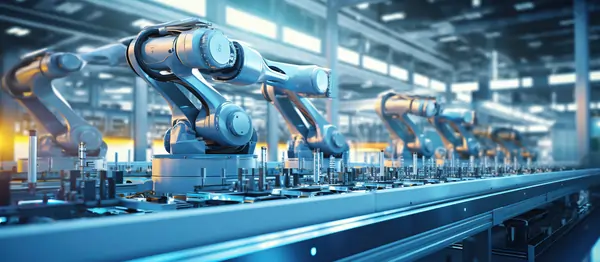While humanoid robots continue to captivate the public imagination with their lifelike movements and sci-fi appeal, the real momentum in robotics lies elsewhere. Specialized robots are AI-powered machines engineered for specific tasks, quietly driving the next wave of industrial automation. From warehouse automation and waste management to logistics and healthcare, these robots prioritize precision, efficiency, and scalability over form. Backed by billions in investment and delivering tangible ROI, specialized robots are emerging as the true workhorses of the AI-powered revolution, setting the stage for a future where function defines success.

According to Reuters and OODA Loop, businesses and investors are now choosing function over style when it comes to robotics. Specialized robots are designed to execute narrow, high-value tasks with unmatched precision and speed. This focus on robotic efficiency is driving unprecedented returns in sectors like logistics, manufacturing, and waste management.
Unlike humanoid robots, which are still grappling with cost, complexity, and versatility issues, specialized robots deliver immediate return on investment. Because they are designed for efficiency, they suit industries where every second of downtime costs money and precise work is needed.
The Acumen Research and Consulting report says that global sales of AI-powered robots could increase from USD 6.2 billion in 2021 to USD 66.6 billion by 2030, at a remarkable CAGR of 30.5%. A significant portion of this growth is being driven by specialized robots tailored to address real-world operational pain points.
This momentum is visible in sectors like warehouse automation and logistics robotics, where robots are no longer novelties but mission-critical assets. When companies use AI-powered robots to predict maintenance needs and improve optimization in real time, it’s clear that specialization is very valuable.
Humanoid robots like UBTECH’s new $20K Walker S or Tesla’s Optimus certainly attract media attention. They try to look and work like people, but they usually fail to meet the expectations for performance and cost. Still, the field is promising, but the current costs and general nature make it hard to use on a large scale.
Specialized robots, on the other hand, are thriving because they solve specific problems. Autonomous mobile robots (AMRs) in warehouses, waste sorting robots in recycling facilities, and palletizing robots in packaging plants don’t need to look like humans; they just need to work, fast and accurately.
Robotics is having a big impact on the logistics industry. The global logistics robotics market is set to grow from USD 7.8 billion in 2022 to USD 35.7 billion by 2032, at a CAGR of 16.6%.
Warehouse automation is fueling this surge, with AI-powered robots performing tasks ranging from picking and palletizing to packaging and internal transport. Palletizing robots, for instance, enhance speed and reduce labor dependency, while AMRs are improving inventory accuracy and space utilization. The infrastructure of today’s supply chain relies on these robots.
Waste management is also being transformed in major ways. The global waste sorting robots market is expected to reach USD 10.3 billion by 2030, up from USD 2.2 billion in 2021. They use modern sensors and artificial intelligence to quickly identify and group recyclable materials.
They help sort waste more efficiently and reduce the risks for human health from hazardous materials. In an era where sustainability is becoming a key business goal, waste sorting robots are helping companies reduce their environmental footprint while improving operational metrics.
Autonomous mobile robots (AMR) are perhaps the most versatile of specialized robots. Robots are now being used in warehouses and hospitals to handle changing situations on their own.
According to Acumen Research and Consulting forecasts, the global AMR market will grow from USD 4.1 billion today to USD 23.8 billion by the end of 2032, with an average annual growth rate of 19.5%. Their uses include everything from packaging to helping patients, proving how versatile they are. Unlike traditional AGVs, AMRs rely on sensors, maps and up-to-date information to operate without issues in complicated sites.
Robotics investment trends are tilting decisively toward functionality. According to Reuters and OODA Loop, businesses that build and deploy robots made for specific tasks are the real winners.
Reuters says that over USD 2.26 billion was raised by robotics companies in Q1 2025 and most of that went to solutions designed for specific tasks. According to OODA Loop, robotics investment reached USD 4.2 billion in the first half of 2024 which is a big increase from the USD 6.8 billion invested in 2023. These figures illustrate growing investor preference for robotic efficiency and specialized solutions.
Venture capital and strategic investors are pouring funds into industrial automation, logistics robotics, and AI-powered machines that offer clear cost-benefit advantages. They are not interested in science fiction—they focus on solving issues businesses face now. Specialized robots are becoming a magnet for smart capital.
Beyond industrial sectors, specialized robots are penetrating military and healthcare domains. Military robots are being deployed for bomb disposal, surveillance, and resupply missions in high-risk zones. Because they are tough and can navigate on their own, they are essential in today’s warfare.
Surgical robots are another fast-growing category. The use of AI-powered robots in surgery helps doctors achieve more precision, make smaller cuts and shorten the time it takes for patients to recover. Specialization is essential, not just something helpful, in this field.
As we move into the next decade, robots are expected to focus more on their functions rather than taking on human shapes. From waste sorting and logistics to defense and healthcare, specialized robots are carving out essential roles across industries.
It reveals that industrial progress now depends on robotics being useful, dependable and profitable, rather than looking human. The rise of specialized robots is not a detour; it’s the main road ahead.